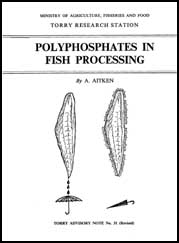Contents Index

Accompanying Notes
Table of Contents
By A. AITKEN
MINISTRY OF AGRICULTURE, FISHERIES AND FOOD
TORRY RESEARCH STATION
TORRY ADVISORY NOTE No. 31 (Revised)
Crown copyright material is reproduced with the permission of the Controller of Her Majesty's Stationery Office.
This electronic document has been scanned using optical character recognition (OCR) software and careful manual recorrection. Even if the quality of digitalisation is high, the FAO declines all responsibility for any discrepancies that may exist between the present document and its original printed version.
Describes polyphosphates and how these are used to improve the retention of water in chilled and frozen fish, to help in the bonding of fillets in laminated blocks and to help in the production of minced fish (recovered fish flesh) blocks. Advises on the preparation and use of polyphosphate solutions and the limitations of polyphosphates. The information is relevant to Notes 51, 52 and 79. The current legislation covering food additives should be consulted to ascertain the maximum permitted levels of phosphates and polyphosphates, individually or in combination, in fish and shellfish products. These indicated maximum quantities are usually expressed as P2O5. Similarly, the current legislation covering food labelling should be consulted to determine whether and in what form information about these additives should be included in the ingredients list on the label for the product.
(FAO in partnership with Support unit for International Fisheries and Aquatic Research, SIFAR, 2001).
Introduction
What are polyphosphates?
How do they help in fish
processing?
What can polyphosphates not
do?
Which polyphosphates are used?
How are they applied?
Are polyphosphates
injurious to health?
Are there patent restrictions?
Contents Index